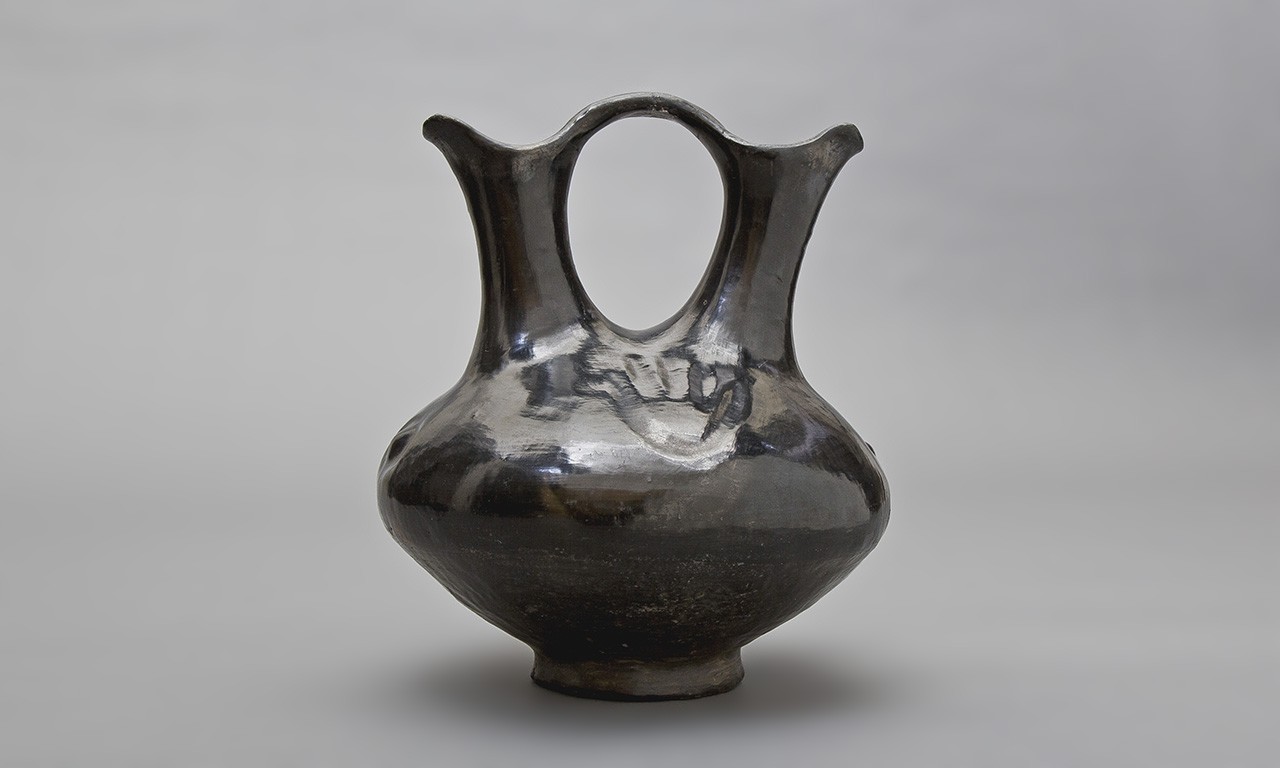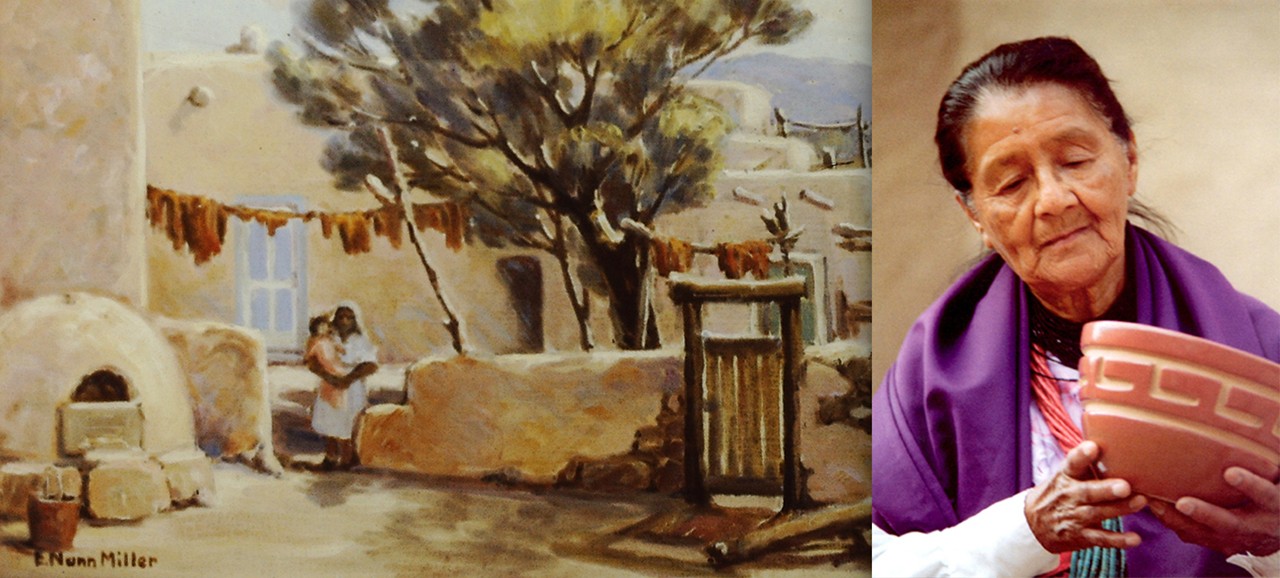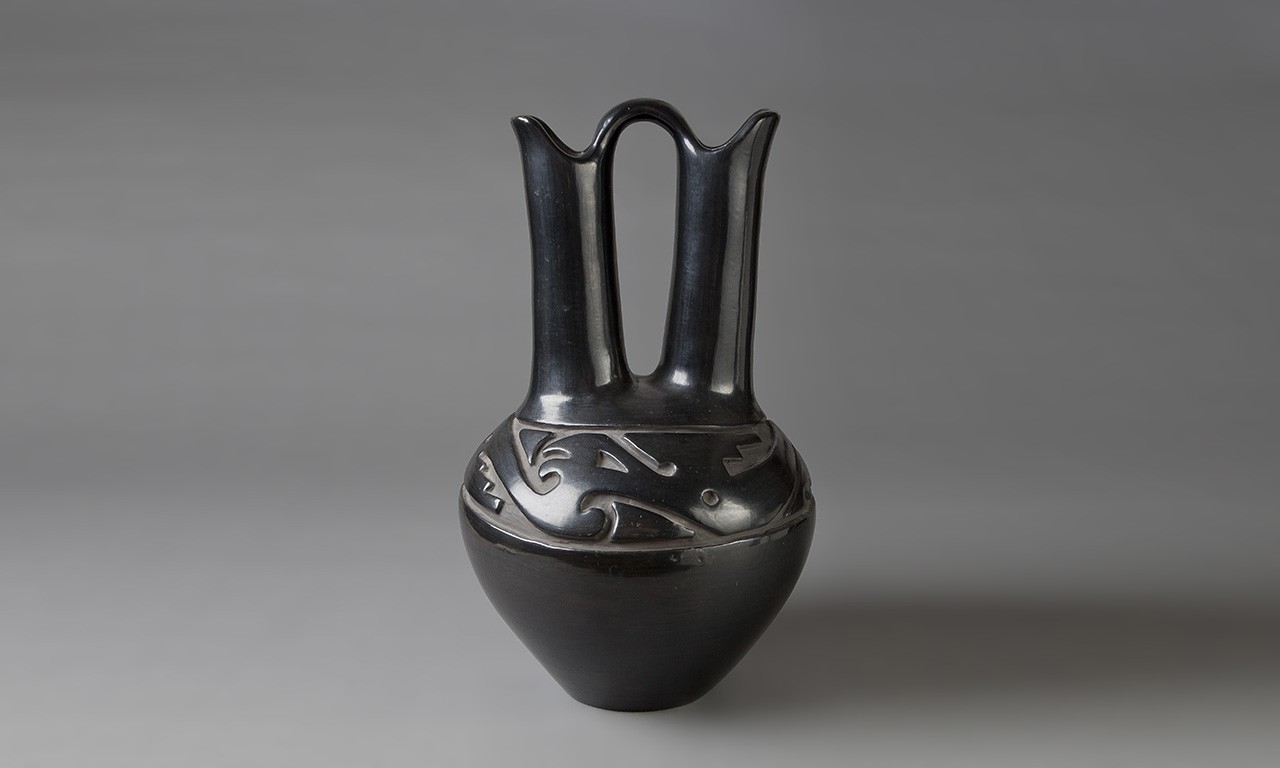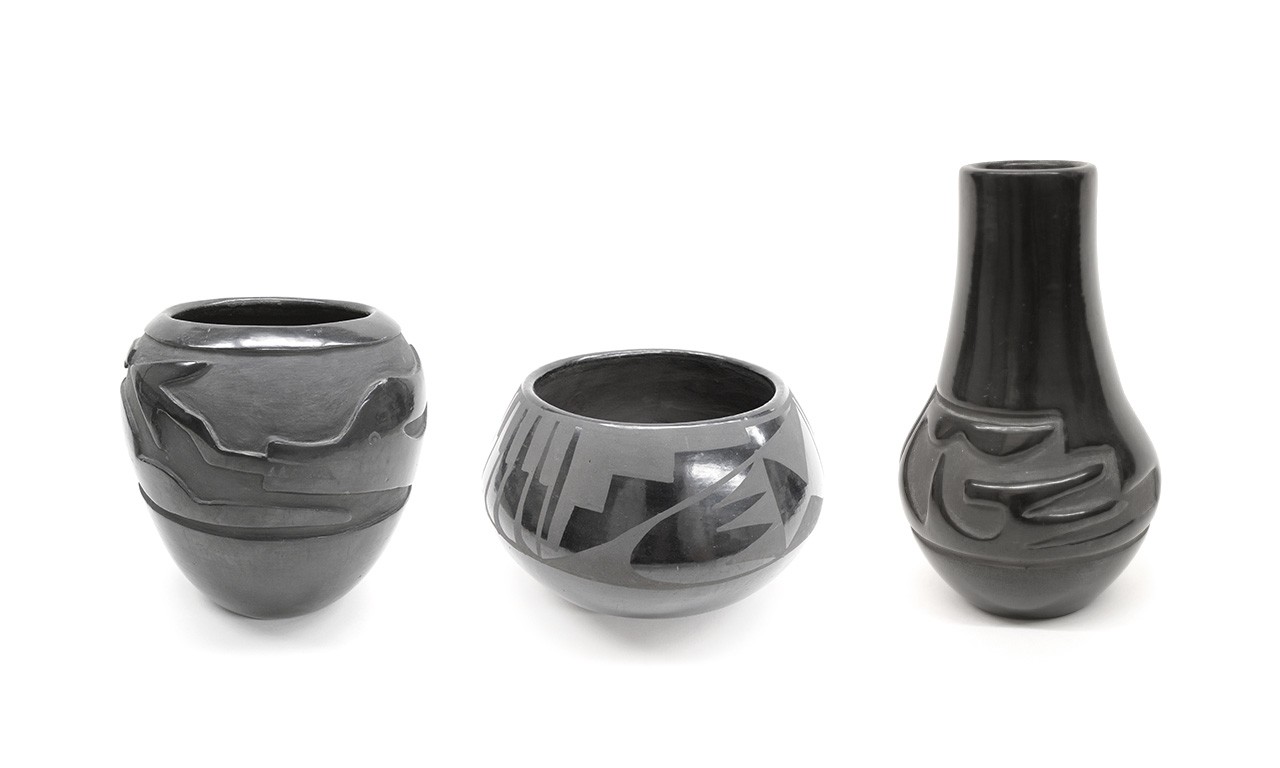 |
Black-on-Black Ware Vessel, 1920-1930
Unknown Artist; Santa Clara Pueblo, New Mexico
Ceramic and pigment; 11 x 9 in.
F83.17.1
Gift of Mrs. Geraldine Davis |
National Native American Heritage Month
When we think about the beautiful pottery vessels of the Southwest, we most likely conjure the image of brilliantly colorful polychrome vessels. Of course, Native American potters made vessels in a whole variety of styles. Among the most striking of these for its stark aesthetic was the black-on-black ware—black vessels with designs carved or painted onto them in black—to come out of San Ildefonso Pueblo, Santa Clara Pueblo and other Tewa pueblos around the beginning of the 20th century. As November marks National Native American Heritage Month, a month dedicated to paying tribute to the cultural heritage of America’s First Peoples, today’s post looks at black-on-black ware from the Santa Clara pueblo which rose to prevalence under Sara Fina Tafoya and her daughters.
Trial and Air Elimination
Pueblo pottery dates far into prehistory, but the emergence of black-on-black pottery in its current form has been a relatively recent development. Maria Martinez was a matriarch of the San Ildefonso Pueblo around the turn of the 20th century. She and her husband worked directly with archaeologists at what is now Bandelier National Monument and uncovered black-on-black vessels dating from the 12th to 17th centuries. Seeing how strikingly beautiful the designs were, she experimented with her kiln, finally managing to replicate the color by firing red clay vessels with hot but otherwise smothered flames to blacken them. They were then further covered with black slips. Though pots made at the end of the 1800s still needed to retain some utilitarian function, by the 1910s when this new style was developed, they were almost exclusively being sold to tourists. Their ornamental use was important, as vessels created with the new process were not watertight.
 |
Santa Clara Pueblo, early 20th Century
Evylena Nunn Miller (American, 1888-1966); Santa Clara Pueblo, New Mexico
Oil on canvas; 30 x 25 in.
19766
Gift of Evylena Nunn Miller |
Margaret Tafoya, date unknown |
Santa Clara Tafoya
The Santa Clara Pueblo was historically known for several things, including its red-on-tan pottery and the unique distinction of having the oldest pueblo pottery vessel with an attributed creator, a polished black storage jar made by Candelaria Tafoya Gutierrez. As it happens, the Tafoya family of potters were the most influential to come from the Santa Clara Pueblo. Sara Fina Tafoya was born in 1863 and in her life transitioned from highly utilitarian vessels to made-for-sale examples. She was known for creating large vessels and for pioneering two techniques which can both be seen in pots made by her daughters: creating impressions in wet clay and carving designs into the fired vessel before polishing. Sara Fina Tafoya had eight children, almost all of whom went on to be potters of varying degrees of acclaim. Margaret Tafoya became perhaps the most renowned for both keeping alive and perfecting the techniques of her mother, while incorporating black-on-black ware from the San Ildefonso Pueblo. She became famous for her work and received several prestigious awards of including Master Traditional Artist and Folk Artist of the Year.
 |
Black-on-Black Ware Wedding Vase, c. 1970
Margaret Tafoya (1904-2001); Santa Clara Pueblo, New Mexico
Clay; 22 1/2 x 42 in.
92.31.1
Anonymous Gift in Honor of Mary Miller, M.D. |
Drinking for Two
At least two of the vessels in this post were made by Margaret Tafoya and her sister Dolorita Tafoya Padilla—who was only known to have made a few pottery vessels in her life. Unfortunately, three of the five were unsigned, still relatively common into the 20th century because pottery had traditionally been considered a communal activity. All of these are black-on-black ware, with some using the San Ildefonso technique of painting on designs with a layer of matte black and others using the method more characteristic of the Santa Clara Pueblo of carving the designs into the vessel before polishing it. From extracting the clay from local deposits to the final firing process, hundreds of hours went into the production of a vessel as large as the 22 ½ in. example featured immediately above. The form of this vase follows its ceremonial function as a drinking vessel shared by the bride and groom during a wedding ceremony. As a symbol of unification, the woman would drink blessed water from one spout before handing it to the man who drank from the opposite spout.
 |
Black-on-Black Ware Vessels, 20th Century
Dolorita Tafoya Padilla and Unknown Artists; Santa Clara Pueblo, New Mexico
Ceramic and pigment
95.71.13, 2013.26.4, and 97.25.4
Gift of Mr. and Mrs. Len and Toni Wood, Mrs. Joan Krotenberg, and Mr. A. P. Henry |
Fluid Dynamics
The bear paw, serpent and stepped kiva designs seen in the vessels of this post are all hallmarks of Tafoya pottery. The repeated use of these motifs is meaningful because both the bear paw and serpent are representative of water in Tewa culture and the function of these vessels would traditionally have been to hold water. It is said that the bear led the people of the Santa Clara Pueblo to water during a drought and Avanyu is a water serpent, a bringer of rains. The Tafoya family will be long remembered for their role in keeping Tewa Pueblo culture alive through their pottery vessels.
Text and images may be under copyright. Please contact Collection Department for permission to use. References are available on request. Information subject to change upon further research.





Comments 1
What a wonderful visual and written delight this blog showcases about the incredible Bowers Museum collection of cultural beauty and significance. I only wish that a space in the museum could be dedicated to some of these fine examples of Native American cultural heritage and art. I imagine the public would enjoy a small, dedicated space in the museum for displaying the monthly blog examples that continually highlights the vast and wide-ranging collection of Bowers in storage. I would certainly enjoy coming to the museum monthly to see the newest and changing installations in person after reading about them on the blog. I know this would be extra work for the museum staff, but it certainly would be a visitor draw for repeated and frequent visits to the museum. Perhaps a curator talk could be included in such a venue on selected days.